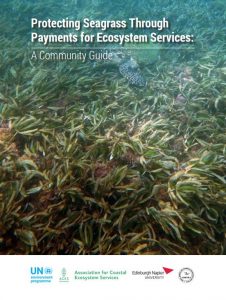Professor of Teaching and Research in Environmental Biology at Edinburgh Napier University, Mark Huxham, recently published a signposting guide with insights on how best to run a community-based seagrass conservation project, using methods such as a Payments for Ecosystems Services (PES) project.
In his report, Prof Huxham focuses on a carbon-based PES as a means to protect seagrass ecosystems and prevent their degradation.
Seagrass meadows appear in 159 different countries and can be found on every continent except from Antarctica. In fact, all-in-all, seagrass covers 30 million hectares worldwide, that’s 10-and-a-half times the size of Hawaii.
These aquatic ecosystems provide an irreplaceable service to our planet. Seagrasses afford valuable nursery habitat to one fifth of the world’s largest fisheries, which helps boost fish population numbers and, in turn, this supports local communities that rely on fish for income and food.
Seagrass also stores up to 18% of the world’s oceanic carbon, helping to mitigate climate change.
These ecosystems therefore play a key role in reducing the impact on climate change, improve water quality, and provide coastal protection against floods and storms.
Now though, like the coral reefs and rainforests, these habitats are being compromised by human activity.
The rapid decline in our global coastal ecosystems is a worldwide problem and the rate of loss of seagrass meadows is alarmingly fast. The most recent census estimates that we are losing 7% of this key marine habitat per year, which is equivalent to a football field of seagrass lost every 30 minutes. Nearly a third of seagrass cover has been lost in the last 100 years-or-so.
The four main culprits behind the destruction of these water-based habitats are overharvesting (humans harvest seagrass for fertiliser, insulation, furniture and more); agricultural and industrial run-off; coastal development; and climate change.
It is a global problem that the United Nations Environment Programme (UNEP) is keen to tackle. In a separate report that Mark Huxham contributes to, detailing the importance of seagrass and how to protect it, UNEP lays out 13 recommended actions on how to protect this natural resource. The recommendations include:
- developing a comprehensive map of global seagrass distribution and health;
- raising awareness of seagrass and communicating its importance to communities;
- and stimulating seagrass conservation and protection through financial initiatives and incentives.
This is the download for the global UNEP report.
This is the download for Mark Huxam’s report on how to help conserve seagrass locally.

